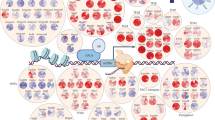Abstract
THE primary function of the start of a message (mRNA for a specific polypeptide) is to ensure the correct initiation of translation. Little is known about the factors determining the frequency of translation or indeed if its variability is important in the total expression of genes. Recently, an analysis was introduced that allows calculation of in vivo frequencies; it was shown that the in vivo initiation rates of the first and last messages of the lac mRNA differ by fivefold1. Different initiation frequencies could be effected, in part at least, by a sequence of three or more nucleotides about 8 to 15 residues upstream from the initiating AUG codon that is complementary to a purine-rich sequence at the end of the 16S ribosomal RNA2,3. Four such complementary nucleotides are residues 8–11 before the AUG start of the β-galactosidase (EC 3.2.1.23, βGase) message. Mutants for this sequence are not available, but there is a whole series for a more distant region—22 to 34 nucleotides before the AUG: the lac Oc mutants. Here we show that certain of these mutations affect the rate of translation as well as the stability of this message.
This is a preview of subscription content, access via your institution
Access options
Subscribe to this journal
Receive 51 print issues and online access
$199.00 per year
only $3.90 per issue
Buy this article
- Purchase on Springer Link
- Instant access to full article PDF
Prices may be subject to local taxes which are calculated during checkout
Similar content being viewed by others
References
Kennell, D. & Riezman, H. J. molec. Biol. 114, 1–21 (1977).
Shine, J. & Dalgarno, L. Proc. natn. Acad. Sci. U.S.A. 71, 1342–1346 (1974).
Steitz, J. A. & Jakes, K. Proc. natn. Acad. Sci. U.S.A. 72, 4734–4738 (1975).
Sadler, J. R. & Smith, T. F. J. molec. Biol. 62, 139–169 (1971); Smith, T. F. & Sadler, J. R. J. molec. Biol. 59, 273–305 (1971).
Gilbert, W., Gralla, J., Majors, J. & Maxam, A., in Protein-Ligand Interactions (eds Sund, H. & Blauer, G.) 193–120 (de Gruyter, Berlin, 1975).
Maizels, N. M. Proc. natn. Acad. Sci. U.S.A. 70, 3585–3589 (1973).
Bourgeois, S., Barkley, M. D., Jobe, A., Sadler, J. R. & Wang, J. C. in Protein-Ligand Interactions (eds Sund, H. & Blauer, G.) 253–269 (de Gruyter, Berlin, 1975).
Craven, G. R., Steers, E. & Anfinsen, C. B. J. biol. Chem. 240, 2468–2477 (1965).
Fowler, A. V. & Zabin, I. Proc. natn. Acad. Sci. U.S.A. 74, 1507–1510 (1977).
Lim, L. W. & Kennell, D. Molec. gen. Genet. 133, 367–371 (1974).
Jacquet, M. & Kepes, A. J. molec. Biol. 60, 453–472 (1971).
Talkad, V., Schneider, E. & Kennell, D. J. molec. Biol. 104, 299–303, (1976).
Maizels, N. Nature 215, 647–649 (1974).
Gralla, J. & Crothers, D. M. J. molec. Biol. 73, 497–511 (1973).
Borer, P. N., Dengler, B., Tinoco, I., Jr & Uhlenbeck, O. J. molec. Biol. 86, 843–853 (1974).
Craig, M. E., Crothers, D. M. & Doty, P. J. molec. Biol. 62, 383–401 (1971).
Tinoco, I., Jr, Borer, P. N., Dengler, B. & Levine, M. D. Nature new Biol. 246, 40–41 (1973).
Kindler, P., Keil, T. U. & Hofschneider, P. H. Molec. gen. Genet. 126, 53–69 (1973).
Talkad, V., Achord, D. & Kennell, D. J. Bact. 135, 528–541 (1978).
Robertson, H. D., Dickson, E. & Dunn, J. J. Proc. natn. Acad. Sci. U.S.A. 74, 822–826 (1977).
Rosenberg, M. & Kramer, R. Proc. natn. Acad. Sci. U.S.A. 74, 984–988 (1977).
Schneider, E., Blundell, M. & Kennell, D. Molec. gen. Genet. 160, 121–129 (1978).
Steege, D. A. Proc. natn. Acad. Sci. U.S.A. 74, 4163–4167 (1977).
Gilbert, W. & Maxam, A. Proc. natn. Acad. Sci. U.S.A. 70, 3581–3584 (1973).
Bahl, C. P., Wu, R., Stawinsky, J. & Narong, S. A. Proc. natn. Acad. Sci. U.S.A. 74, 966–970 (1977).
Anderson, E. H. Proc. natn. Acad. Sci. U.S.A. 32, 120–128 (1946).
Kepes, A. Biochim. biophys. Acta 76, 293–309 (1963).
Schwartz, T., Craig, E. & Kennell, D. J. molec. Biol. 54, 299–311 (1970).
Author information
Authors and Affiliations
Rights and permissions
About this article
Cite this article
CANNISTRARO, V., KENNELL, D. Escherichia coli lac operator mRNA affects translation initiation of β-galactosidase mRNA. Nature 277, 407–409 (1979). https://doi.org/10.1038/277407a0
Received:
Accepted:
Issue Date:
DOI: https://doi.org/10.1038/277407a0
This article is cited by
-
Effects of inducer levels on a recombinant bacterial biofilm formation and gene expression
Biotechnology Letters (1994)
-
The functional stability of the lacZ transcript is sensitive towards sequence alterations immediately downstream of the ribosome binding site
Molecular and General Genetics MGG (1987)
-
The effect of urea on catabolite sensitive operons in Escherichia coli K 12
Molecular and General Genetics MGG (1980)
Comments
By submitting a comment you agree to abide by our Terms and Community Guidelines. If you find something abusive or that does not comply with our terms or guidelines please flag it as inappropriate.



